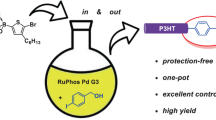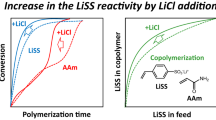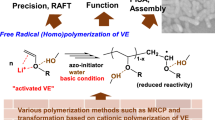Abstract
Generally, conventional free-radical polymerization of an allyl monomer affords low-molecular-weight oligomers. However, since the allyl monomer can form a charge transfer complex with maleic anhydride (MA), in which the former acts as an electron donor and the latter acts as an acceptor, relatively high-molecular-weight alternating copolymers can be obtained via copolymerization of an allyl monomer and MA. In this study, hydrophilic alternating copolymers (P(11EO/MA)m) of methoxy poly(ethylene glycol) allyl ether (11EO) and MA were prepared via reversible addition–fragmentation chain transfer (RAFT)-controlled radical polymerization. The alternating nature of the polymers was confirmed by the consumption of both monomers during polymerization. The MA units in P(11EO/MA)m were hydrolyzed to prepare pendant carboxylic acid group-containing polymers (P(11EO/MH)m). Furthermore, an amphiphilic diblock copolymer (P(11EO/MH)m-PSn) was prepared via RAFT copolymerization of styrene monomer using P(11EO/MH)m as a macro-chain transfer agent. The association behavior of P(11EO/MH)m-PSn in water was also investigated.
This is a preview of subscription content, access via your institution
Access options
Subscribe to this journal
Receive 12 print issues and online access
$259.00 per year
only $21.58 per issue
Buy this article
- Purchase on Springer Link
- Instant access to full article PDF
Prices may be subject to local taxes which are calculated during checkout








Similar content being viewed by others
References
Bartlett PD, Tate FA. The polymerization of allyl compounds. VI. The polymerization of allyl-1-d2 acetate and the mechanism of its chain termination. J Am Chem Soc. 1953;75:91–5.
Laible RC. Allyl polymerizations. Chem Rev. 1985;58:807–43.
Zubov VP, Kumar MV, Masterova MN, Kabanov VA. Reactivity of allyl monomers in radical polymerization. J Polym Sci A: Polym Chem. 1979;A13:111–31.
Hill DJT, O'Donnell HJ, Perera MCS, Pomery PJ. Polymerization kinetics of allyl monomers at low conversions. Eur Polym J. 1997;33:1353–64.
Negrell-Guirao C, David G, Boutevin B, Chougrani K. Synthesis of novel copolymers obtained from acceptor/donor radical copolymerization of phosphonated allyl monomers and maleic anhydride. J Polym Sci Part A: Polym Chem. 2011;49:3905–10.
Wang Y, Ai Q, Lu J. RAFT radical copolymerization of beta-pinene with maleic anhydride and aggregation behaviors of their copolymer in aqueous solution. Polym Chem. 2015;53:1422–9.
Houlihan FM, Wallow TI, Nalamasu O, Reichmanis E. Synthesis of cycloolefin-maleic anhydride alternating copolymers for 193 nm imaging. Macromolecules. 1997;30:6517–24.
Baranello MP, Bauer L, Benoit DSW. Poly(styrene-alt-maleic anhydride)-based diblock copolymer micelles exhibit versatile hydrophobic drug loading, drug-dependent release, and internalization by multidrug resistant ovarian cancer cells. Biomacromolecules. 2014;15:2629–41.
Bouvet-Marchand A, Chatard C, Graillot A, Boutevin G, Loubat C, Grosso D. Influence of experimental parameters on the side reactions of hydrosilylation of allyl polyethers studied by a fractional factorial design. React Chem Eng. 2018;3:696–706.
Tian Y, Zhu X, Deng Y, Wang K. Copolymerization kinetics of polyetyhylenglycol allylether type polycarboxylate superplasticizer. Adv Mater Res. 2014;936:1393–8.
Mitsukami Y, Donovan MS, Lowe AB, McCormick CL. Water-soluble polymers. 81. Direct synthesis of hydrophilic styrenic-based komopolymers and block copolymers in aqueous solution via RAFT. Macromolecules. 2001;34:2248–56.
Bartlett PD, Altschul R. The polymerization of allyl compounds. I. Factors governing the acyl peroxide-induced polymerization of allyl acetate, and the fate of the peroxide. J Am Chem Soc. 1945;67:812–6.
Laible RC. Allyl polymerizations. Chem Rev. 1958;58:807–43.
Joshi RM. The free radical polymerization of maleic anhydride. Macromol Chem Phys. 1962;53:33–45.
Habbaba A, Lange A, Plank J. Synthesis and performance of a modified polycarboxylate dispersant for concrete possessing enhanced cement compatibility. J Appl Polym Sci. 2013;129:346–53.
Conte T, Plank J. Impact of molecular structure and composition of polycarboxylate comb polymers on the flow properties of alkali-activated slag. Cem Concr Res. 2019;116:95–101.
Huder K, Bantle S, Lutz P, Buchard W. Hydrodynamic and thermodynamic behavior of short-chain polystyrene in toluene and cyclohexane at 34.5 °C. Macromolecules. 1985;18:1461–7.
Akcasu AZ, Han CC. Molecular weight and temperature dependence of polymer dimensions in solution. Macromolecules. 1979;12:276–80.
Konishi T, Yoshizaki T, Yamakawa H. On the “universal constants” ρ and Φ of flexible polymers. Macromolecules. 1991;24:5614–22.
Kalyanasundaram K, Thomas JK. Environmental effects on vibronic band intensities in pyrene monomer fluorescence and their application in studies of micellar systems. J Am Chem Soc. 1977;99:2039–44.
Wilhelm M, Zhao CL, Wang Y, Xu R, Winnik MA. Poly(styrene-ethylene oxide) block copolymer micelle formation in water: a fluorescence probe study. Macromolecules. 1991;24:1033–40.
Acknowledgements
This work was funded by a Grant-in-Aid for Scientific Research, KAKENHI (17H03071 and 16K14008) from the Japan Society for the Promotion of Science (JSPS), JSPS Bilateral Joint Research Projects, and the Cooperative Research Program of “Network Joint Research Center for Materials and Devices (20184035).”
Author information
Authors and Affiliations
Corresponding author
Ethics declarations
Conflict of interest
The authors declare that they have no conflict of interest.
Additional information
Publisher’s note Springer Nature remains neutral with regard to jurisdictional claims in published maps and institutional affiliations.
Supplementary information
Rights and permissions
About this article
Cite this article
Ohshio, M., Mizoue, Y., Shiino, D. et al. Preparation of an amphiphilic diblock copolymer composed of polystyrene and hydrophilic alternating copolymer blocks. Polym J 52, 189–197 (2020). https://doi.org/10.1038/s41428-019-0278-0
Received:
Revised:
Accepted:
Published:
Issue Date:
DOI: https://doi.org/10.1038/s41428-019-0278-0



